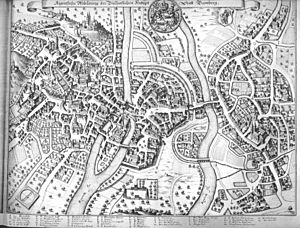Battle of Bamberg facts for kids
Quick facts for kids Battle of Bamberg |
|||||||
|---|---|---|---|---|---|---|---|
| Part of the Thirty Years' War | |||||||
 Bamberg in 1648 |
|||||||
|
|||||||
| Belligerents | |||||||
| Commanders and leaders | |||||||
| Strength | |||||||
| 22,000 | 12,000 | ||||||
| Casualties and losses | |||||||
| Unknown | 4,000, mostly deserted | ||||||
The Battle of Bamberg took place on March 9, 1632. It was an important fight during the Thirty Years' War. In this battle, the army of the Catholic League surprised and defeated the Swedish forces. The Catholic League was led by Count Tilly. The Swedish forces were led by Gustav Horn. After their victory, the Catholic League captured the city of Bamberg.
Contents
Why the Battle Happened
Sweden's Advance in Germany
After winning the Battle of Breitenfeld, the Swedish king Gustavus Adolphus became very powerful. In 1631, his army took control of large parts of northern and central Germany. The armies of the Emperor and the Catholic League were pushed back. They had to retreat to areas like Westphalia, Bavaria, and Austria.
Most of the Swedish army spent the winter near Mainz. King Gustavus Adolphus set up his main base there.
Swedish Control of Bamberg
A part of the Swedish army, led by General Horn, stayed active. They captured several towns in a region called Franconia. General Horn's army had about 12,000 soldiers. Only two of his regiments were Swedish. The rest were new German recruits.
On February 10, Horn's forces captured Bamberg. This city was the capital of the Prince-Bishopric of Bamberg. The city's defense was left to its citizens and local soldiers. The trained soldiers of the Catholic League had already left. After a short siege of only nine hours, Bamberg's defenders gave up. They ran out of ammunition, so the Swedes took control of the city.
The Battle of Bamberg
Tilly's Counterattack
In March, the Catholic League began to fight back. Their leader, Count Tilly, gathered his forces. He brought in soldiers from the Upper Palatinate. He also added 8,000 men from the Bavarian local army.
Tilly marched his army from Nördlingen towards Bamberg. They arrived on the evening of March 9. His first soldiers attacked the Swedish cavalry (horseback soldiers) outside the city.
Fighting in the City
The fleeing Swedish cavalry caused panic among the defenders in eastern Bamberg. Tilly's army broke through the defenses near the Monastery of the Holy Sepulchre. The eastern part of the city, which had unfinished trenches, was quickly abandoned by the Swedes.
However, the bridge over the Regnitz river was important. It led to the city center and was strongly defended. Two of Horn's Swedish regiments managed to take back the bridge completely.
The Bridge and Retreat
Count Tilly then ordered two large cannons to be placed in a beer garden. From there, they could fire down on the bridge. After the cannons fired, the Swedes had to leave the bridge. The Swedish commander, Count Solms-Laubach, was badly hurt during this shelling and later died.
The fighting continued until midnight. Finally, the Swedish army gave up defending the city. General Horn lost about a third of his men. Many of them left the army. Horn then retreated with his remaining forces to Schweinfurt.
What Happened Next
After his victory, Count Tilly's army was too tired to keep pushing forward. Meanwhile, King Gustavus Adolphus needed another win. He wanted to show his German allies, like Württemberg, that Sweden was still strong.
The king marched from Mainz to Nuremberg. Along the way, he gathered the remaining soldiers from Horn's defeated army. On March 31, Gustavus Adolphus arrived in Nuremberg. People there welcomed him as a hero. A week later, he captured Donauwörth. This helped him gather enough men to invade Bavaria.

